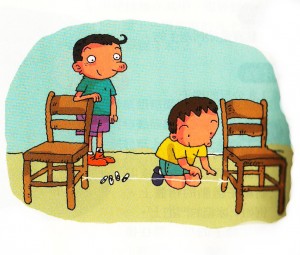
Set UP:
Secure a 3 feet (1m) string between two stationary objects. The string should be taut. Clip paper clips to the string so that they hang freely and can spin around the string. The number of paper clips is up to you. You might try some of the colored paper clips just for fun. Be sure and space the paperclips along the string.
Pluck the string and and observe the motion of the paper clips. Experiment with the position of the paper clips. You want to be able to place some of the paper clips on the string where they will spin around the string while others vibrate but remain relatively vertical.
So What’s the Science Behind this Magic?

Where the string is plucked, wave energy moves along the string in both directions. If you look close you might be able to can see the string moving up and down. The string is only moving up and down, but the wave energy is moving back and forth along the string. In the Standing Wave diagram, the dotted red line shows a stationary string being held tight. The black solid line as well as the black dashed line show the standing wave. When the first wave moves up, the second wave is down and the third wave is up. In a fraction of a second the reverse of the occurs as shown by the dotted black line.
The points on the string that do not move up and down, only vibrates in place. The tops and bottoms of the waves are called antinodes and is where there is maximum motion and is the location where a paperclip will spin around the string.
Big Book of Science Experiments
A book of fun informative experiments about astronomy, biology, chemistry, earth science, and physics.
(Paid Link)
